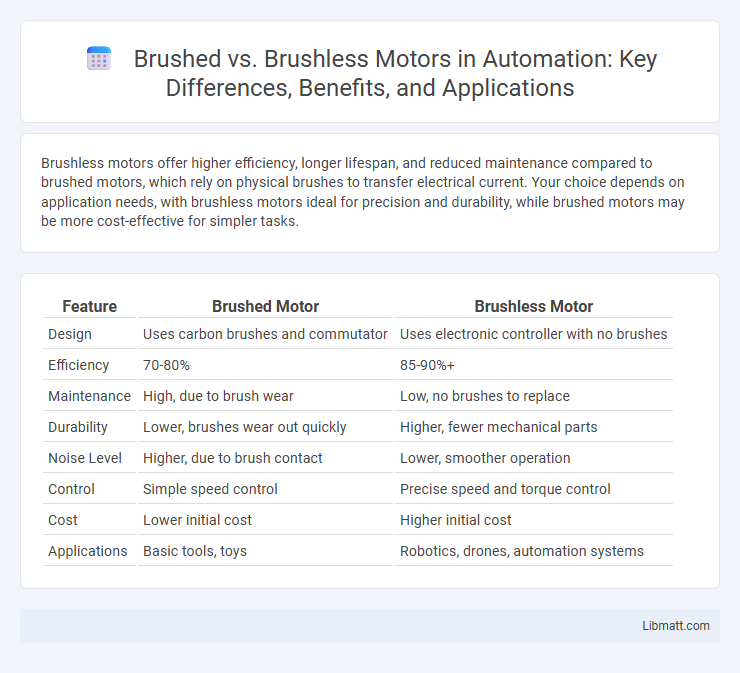Brushless motors offer higher efficiency, longer lifespan, and reduced maintenance compared to brushed motors, which rely on physical brushes to transfer electrical current. Your choice depends on application needs, with brushless motors ideal for precision and durability, while brushed motors may be more cost-effective for simpler tasks.
Table of Comparison
| Feature | Brushed Motor | Brushless Motor |
|---|---|---|
| Design | Uses carbon brushes and commutator | Uses electronic controller with no brushes |
| Efficiency | 70-80% | 85-90%+ |
| Maintenance | High, due to brush wear | Low, no brushes to replace |
| Durability | Lower, brushes wear out quickly | Higher, fewer mechanical parts |
| Noise Level | Higher, due to brush contact | Lower, smoother operation |
| Control | Simple speed control | Precise speed and torque control |
| Cost | Lower initial cost | Higher initial cost |
| Applications | Basic tools, toys | Robotics, drones, automation systems |
Introduction to Brushed and Brushless Motors
Brushed motors use carbon brushes to transfer electricity, causing friction and wear, which limits their lifespan and efficiency. Brushless motors eliminate brushes by using electronic commutation, resulting in higher efficiency, reduced maintenance, and longer durability. Understanding the difference between these two motor types helps you select the best option for your application's performance and longevity requirements.
How Brushed Motors Work
Brushed motors operate using a simple mechanism where brushes conduct current between stationary wires and the rotating armature, creating a magnetic field that causes the rotor to spin. The commutator reverses the current direction within the windings, maintaining rotational motion. This mechanical system results in more friction and wear compared to brushless motors, limiting efficiency and lifespan.
How Brushless Motors Operate
Brushless motors operate using electronic controllers that switch the current in the motor windings, creating a rotating magnetic field that drives the rotor without the need for brushes. This design reduces friction and wear, improving efficiency and extending the lifespan compared to brushed motors. Your devices benefit from smoother, quieter operation and enhanced performance due to the precise control offered by brushless technology.
Key Differences Between Brushed and Brushless Motors
Brushed motors use carbon brushes to transfer electricity to the spinning armature, leading to higher maintenance and lower efficiency compared to brushless motors, which utilize electronic commutation for improved performance. Brushless motors offer longer lifespan, greater power output, and quieter operation due to the absence of friction from brushes. Your choice between brushed and brushless motors should consider factors like durability, efficiency, and application-specific power needs.
Efficiency Comparison: Brushed vs Brushless
Brushless motors exhibit higher efficiency than brushed motors due to their reduced friction and electrical losses, often reaching efficiency rates above 85-90%. Brushed motors, limited by mechanical wear and sparking within the commutator, typically achieve lower efficiencies around 75-80%. The superior efficiency of brushless motors results in less heat generation and longer lifespan, making them ideal for high-performance and energy-sensitive applications.
Maintenance Requirements and Longevity
Brushless motors require significantly less maintenance than brushed motors because they lack brushes that wear out and need replacement. The absence of brushes reduces friction and heat generation, enhancing the motor's longevity and operational efficiency. Your equipment will benefit from the extended lifespan and lower downtime associated with brushless motor technology.
Cost Analysis: Initial Purchase and Long-term Value
Brushed motors typically have a lower initial purchase cost due to simpler design and cheaper materials, making them ideal for budget-sensitive applications. Brushless motors offer higher long-term value through increased efficiency, reduced maintenance, and longer lifespan, which translates to lower operational costs over time. Your decision should weigh upfront affordability against ongoing savings and performance benefits.
Common Applications for Brushed vs Brushless Motors
Brushed motors are commonly found in household appliances, toys, and power tools where cost-effectiveness and simplicity are priorities. Brushless motors excel in drones, electric vehicles, and high-performance industrial equipment due to their efficiency, reliability, and longer lifespan. Understanding these applications helps you choose the right motor type for your specific needs.
Performance Factors: Speed, Torque, and Control
Brushed motors offer simpler speed control but typically provide lower torque and efficiency compared to brushless motors, which deliver higher speed ranges, improved torque output, and enhanced precision due to electronic commutation. Brushless motors generate less heat and experience reduced wear, leading to longer lifespan and more reliable performance under variable loads. Your choice between brushed and brushless motors impacts overall system responsiveness, energy consumption, and maintenance demands based on these critical performance factors.
Choosing the Right Motor for Your Needs
Choosing between brushed and brushless motors depends on your specific application requirements, such as efficiency, maintenance, and cost. Brushless motors offer higher efficiency, longer lifespan, and better performance in demanding environments, making them ideal for precision tools and electric vehicles. Brushed motors, while more affordable and simpler in design, suit low-cost, low-maintenance tasks where durability is less critical.
Brushed vs Brushless Motor Infographic

 libmatt.com
libmatt.com